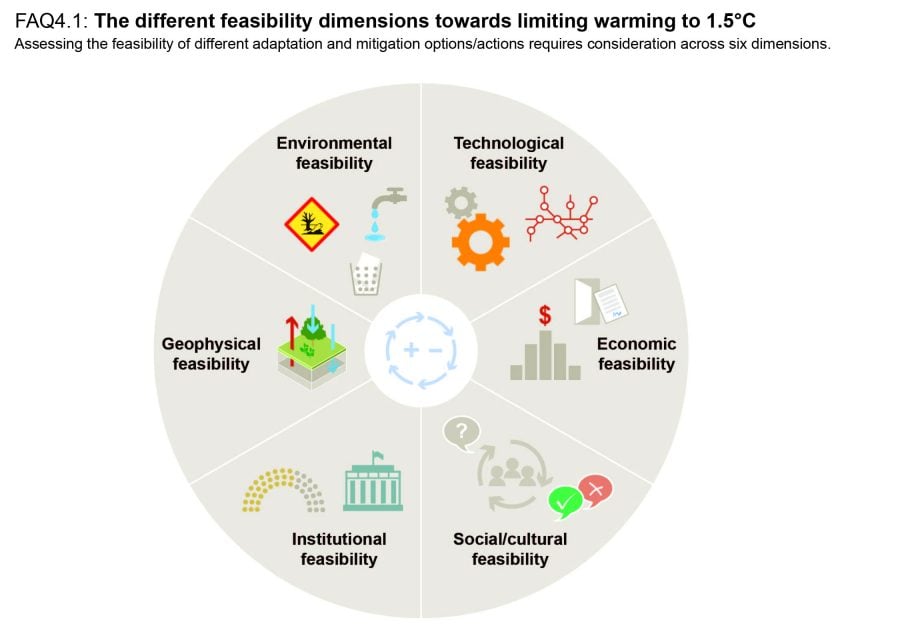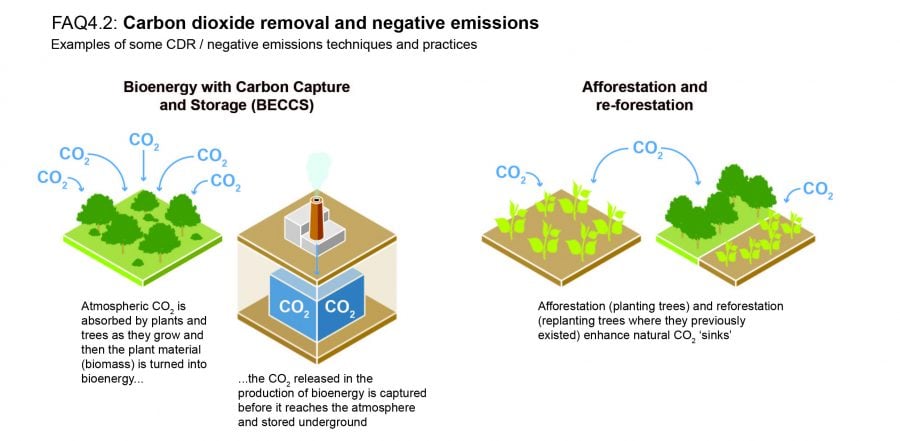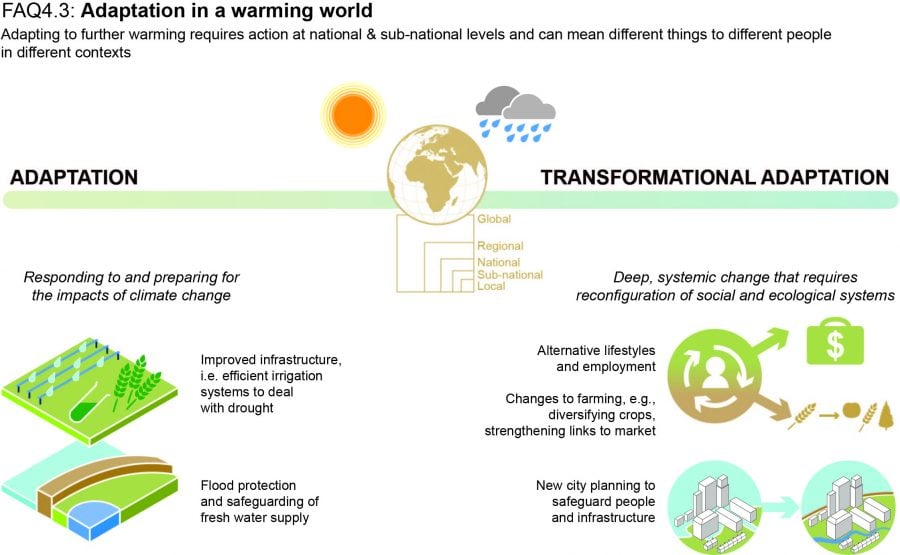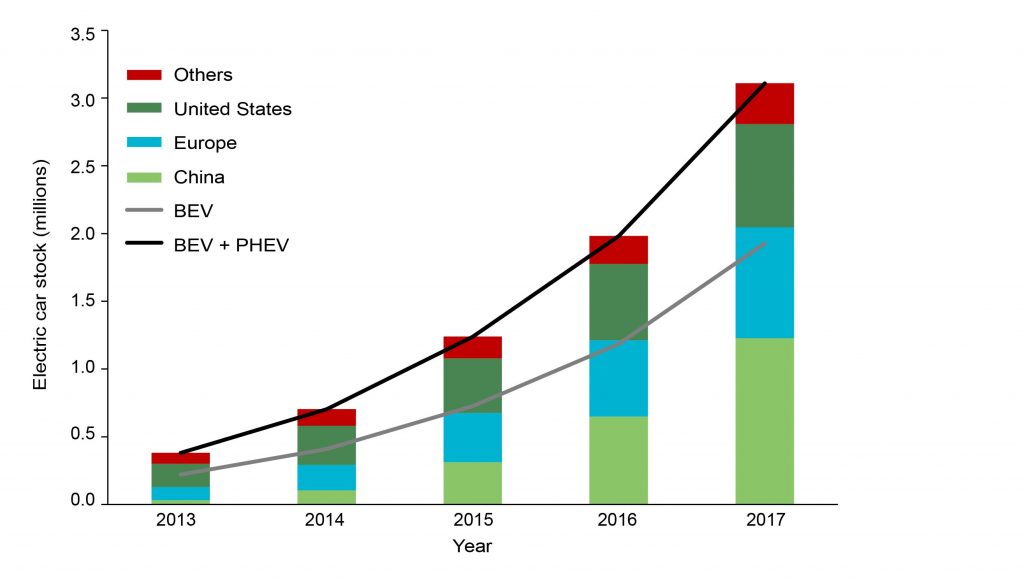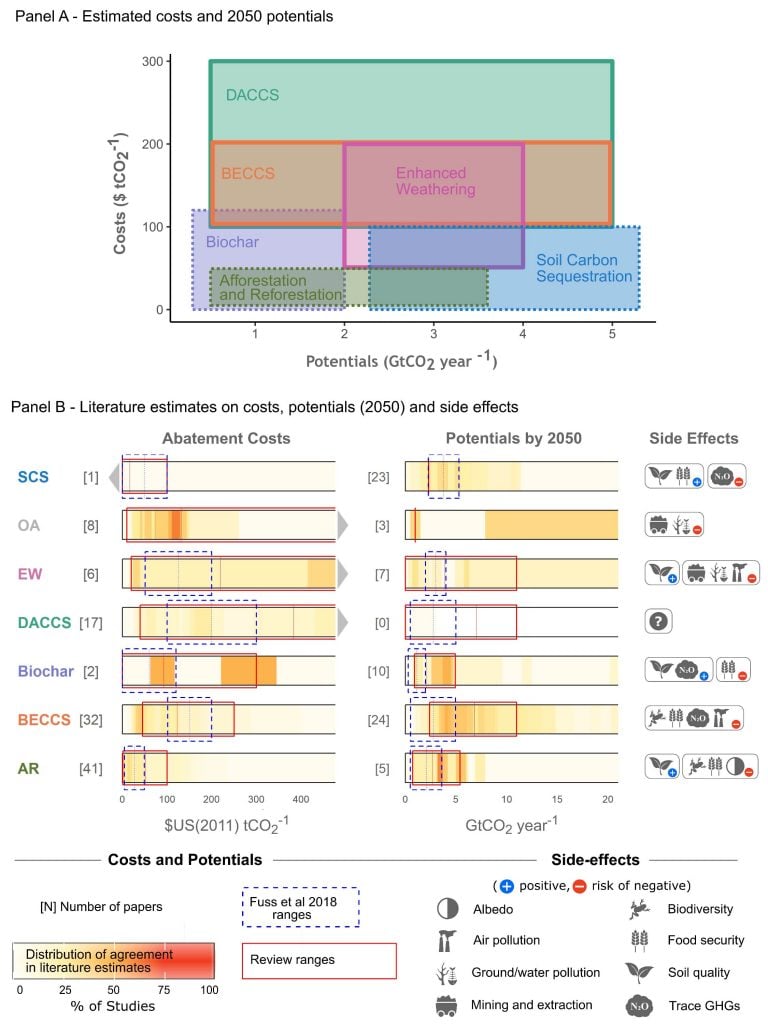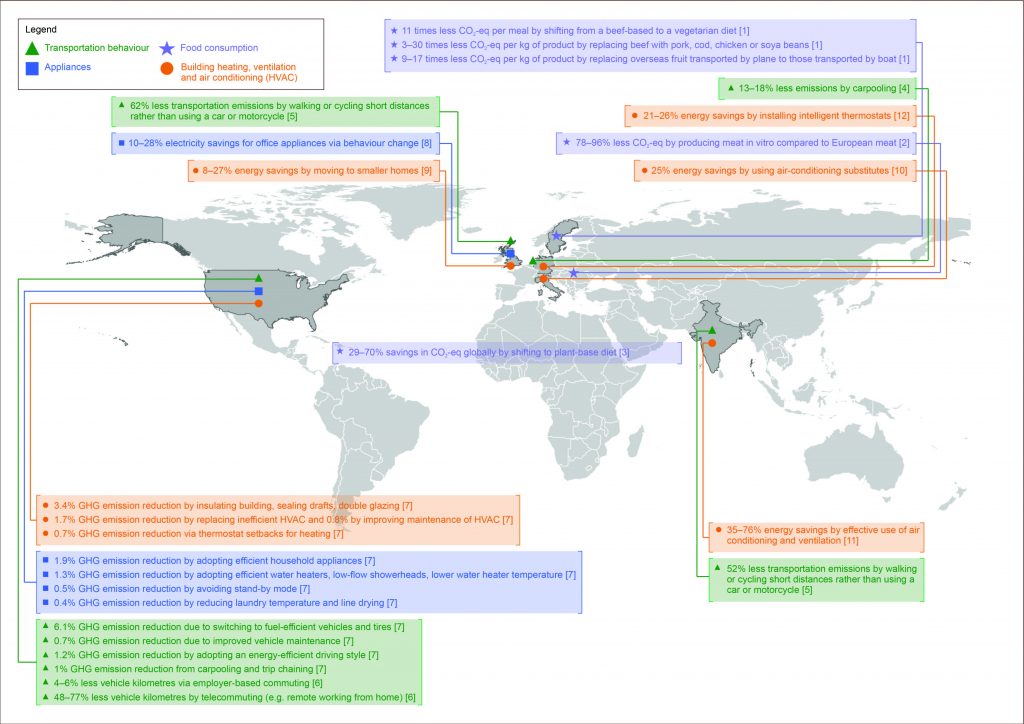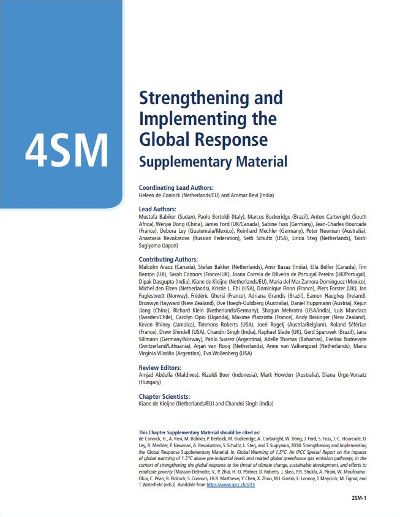ES
Executive Summary
Limiting warming to 1.5°C above pre-industrial levels would require transformative systemic change, integrated with sustainable development. Such change would require the upscaling and acceleration of the implementation of far- reaching, multilevel and cross-sectoral climate mitigation and addressing barriers. Such systemic change would need to be linked to complementary adaptation actions, including transformational adaptation, especially for pathways that temporarily overshoot 1.5°C (medium evidence,high agreement) {Chapter 2, Chapter 3, 4.2.1, 4.4.5, 4.5}. Current national pledges on mitigation and adaptation are not enough to stay below the Paris Agreement temperature limits and achieve its adaptation goals. While transitions in energy efficiency, carbon intensity of fuels, electrification and land-use change are underway in various countries, limiting warming to 1.5°C will require a greater scale and pace of change to transform energy, land, urban and industrial systems globally. {4.3, 4.4, Cross-Chapter Box 9 in this Chapter}
Although multiple communities around the world are demonstrating the possibility of implementation consistent with 1.5°C pathways {Boxes 4.1-4.10}, very few countries, regions, cities, communities or businesses can currently make such a claim (high confidence). To strengthen the global response, almost all countries would need to significantly raise their level of ambition. Implementation of this raised ambition would require enhanced institutional capabilities in all countries, including building the capability to utilize indigenous and local knowledge (medium evidence, high agreement). In developing countries and for poor and vulnerable people, implementing the response would require financial, technological and other forms of support to build capacity, for which additional local, national and international resources would need to be mobilized (high confidence). However, public, financial, institutional and innovation capabilities currently fall short of implementing far-reaching measures at scale in all countries (high confidence). Transnational networks that support multilevel climate action are growing, but challenges in their scale-up remain. {4.4.1, 4.4.2, 4.4.4, 4.4.5, Box 4.1, Box 4.2, Box 4.7}
Adaptation needs will be lower in a 1.5°C world compared to a 2°C world (high confidence) {Chapter 3; Cross-Chapter Box 11 in this chapter}. Learning from current adaptation practices and strengthening them through adaptive governance {4.4.1}, lifestyle and behavioural change {4.4.3} and innovative financing mechanisms {4.4.5} can help their mainstreaming within sustainable development practices.Preventing maladaptation,drawing on bottom-up approaches
{Box 4.6} and using indigenous knowledge {Box 4.3} would effectively engage and protect vulnerable people and communities. While adaptation finance has increased quantitatively, significant further expansion would be needed to adapt to 1.5°C. Qualitative gaps in the distribution of adaptation finance, readiness to absorb resources, and monitoring mechanisms undermine the potential of adaptation finance to reduce impacts. {Chapter 3, 4.4.2, 4.4.5, 4.6}
System Transitions
The energy system transition that would be required to limit global warming to 1.5°C above pre-industrial conditions is underway in many sectors and regions around the world (medium evidence, high agreement). The political, economic, social and technical feasibility of solar energy, wind energy and electricity storage technologies has improved dramatically over the past few years, while that of nuclear energy and carbon dioxide capture and storage (CCS) in the electricity sector have not shown similar improvements. {4.3.1}
Electrification, hydrogen, bio-based feedstocks and substitution, and, in several cases, carbon dioxide capture, utilization and storage (CCUS), would lead to the deep emissions reductions required in energy-intensive industries to limit warming to 1.5°C. However, those options are limited by institutional, economic and technical constraints, which increase financial risks to many incumbent firms (medium evidence, high agreement). Energy efficiency in industry is more economically feasible and helps enable industrial system transitions but would have to be complemented with greenhouse gas (GHG)-neutral processes or carbon dioxide removal (CDR) to make energy-intensive industries consistent with 1.5°C (high confidence).
{4.3.1, 4.3.4}
Global and regional land-use and ecosystems transitions and associated changes in behaviour that would be required to limit warming to 1.5°C can enhance future adaptation and land-based agricultural and forestry mitigation potential. Such transitions could, however, carry consequences for livelihoods that depend on agriculture and natural resources {4.3.2, Cross- Chapter Box 6 in Chapter 3}. Alterations of agriculture and forest systems to achieve mitigation goals could affect current ecosystems and their services and potentially threaten food, water and livelihood security. While this could limit the social and environmental feasibility of land-based mitigation options, careful design and implementation could enhance their acceptability and support sustainable development objectives (medium evidence, medium agreement). {4.3.2, 4.5.3}
Changing agricultural practices can be an effective climate adaptation strategy. A diversity of adaptation options exists, including mixed crop-livestock production systems which can be a cost-effective adaptation strategy in many global agriculture systems (robust evidence, medium agreement). Improving irrigation efficiency could effectively deal with changing global water endowments, especially if achieved via farmers adopting new behaviours and water- efficient practices rather than through large-scale infrastructural interventions (medium evidence, medium agreement). Well-designed adaptation processes such as community-based adaptation can be effective depending upon context and levels of vulnerability. {4.3.2, 4.5.3}
Improving the efficiency of food production and closing yield gaps have the potential to reduce emissions from agriculture, reduce pressure on land, and enhance food security and future mitigation potential (high confidence). Improving productivity of existing agricultural systems generally reduces the emissions intensity of food production and offers strong synergies with rural development, poverty reduction and food security objectives, but options to reduce absolute emissions are limited unless paired with demand-side measures. Technological innovation including biotechnology, with adequate safeguards, could contribute to resolving current feasibility constraints and expand the future mitigation potential of agriculture.
{4.3.2, 4.4.4}
Shifts in dietary choices towards foods with lower emissions and requirements for land, along with reduced food loss and waste, could reduce emissions and increase adaptation options (high confidence). Decreasing food loss and waste and changing dietary behaviour could result in mitigation and adaptation (high confidence) by reducing both emissions and pressure on land, with significant co-benefits for food security, human health and sustainable development {4.3.2, 4.4.5, 4.5.2, 4.5.3, 5.4.2}, but evidence of successful policies to modify dietary choices remains limited.
Mitigation and Adaptation Options and Other Measures
A mix of mitigation and adaptation options implemented in a participatory and integrated manner can enable rapid, systemic transitions – in urban and rural areas – that are necessary elements of an accelerated transition consistent with limiting warming to 1.5°C. Such options and changes are most effective when aligned with economic and sustainable development, and when local and regional governments are supported by national governments {4.3.3, 4.4.1, 4.4.3}. Various mitigation options are expanding rapidly across many geographies. Although many have development synergies, not all income groups have so far benefited from them. Electrification, end-use energy efficiency and increased share of renewables, amongst other options, are lowering energy use and decarbonizing energy supply in the built environment, especially in buildings. Other rapid changes needed in urban environments include demotorization and decarbonization of transport, including the expansion of electric vehicles, and greater use of energy-efficient appliances (medium evidence, high agreement). Technological and social innovations can contribute to limiting warming to 1.5°C, for example, by enabling the use of smart grids, energy storage technologies and general-purpose technologies, such as information and communication technology (ICT) that can be deployed to help reduce emissions. Feasible adaptation options include green infrastructure, resilient water and urban ecosystem services, urban and peri-urban agriculture, and adapting buildings and land use through regulation and planning (medium evidence, medium to high agreement). {4.3.3, 4.4.3, 4.4.4}
Synergies can be achieved across systemic transitions through several overarching adaptation options in rural and urban areas. Investments in health, social security and risk sharing and spreading are cost-effective adaptation measures with high potential for scaling up (medium evidence, medium to high agreement). Disaster risk management and education-based adaptation have lower prospects of scalability and cost-effectiveness (medium evidence, high agreement) but are critical for building adaptive capacity. {4.3.5, 4.5.3}
Converging adaptation and mitigation options can lead to synergies and potentially increase cost-effectiveness, but multiple trade-offs can limit the speed of and potential for scaling up. Many examples of synergies and trade-offs exist in all sectors and system transitions. For instance, sustainable water management (high evidence, medium agreement) and investment in green infrastructure (medium evidence, high agreement) to deliver sustainable water and environmental services and to support urban agriculture are less cost-effective than other adaptation options but can help build climate resilience. Achieving the governance, finance and social support required to enable these synergies and to avoid trade-offs is often challenging, especially when addressing multiple objectives, and attempting appropriate sequencing and timing of interventions. {4.3.2, 4.3.4, 4.4.1, 4.5.2, 4.5.3, 4.5.4}
Though CO2 dominates long-term warming, the reduction of warming short-lived climate forcers (SLCFs), such as methane and black carbon, can in the short term contribute significantly to limiting warming to 1.5°C above pre-industrial levels. Reductions of black carbon and methane would have substantial co-benefits (high confidence), including improved health due to reduced air pollution. This, in turn, enhances the institutional and socio- cultural feasibility of such actions. Reductions of several warming SLCFs are constrained by economic and social feasibility (low evidence, high agreement). As they are often co-emitted with CO2, achieving the energy, land and urban transitions necessary to limit warming to 1.5°C would see emissions of warming SLCFs greatly reduced. {2.3.3.2, 4.3.6}
Most CDR options face multiple feasibility constraints, which differ between options, limiting the potential for any single option to sustainably achieve the large-scale deployment required in the 1.5°C-consistent pathways described in Chapter 2 (high confidence). Those 1.5°C pathways typically rely on bioenergy with carbon capture and storage (BECCS), afforestation and reforestation (AR), or both, to neutralize emissions that are expensive to avoid, or to draw down CO2 emissions in excess of the carbon budget {Chapter 2}. Though BECCS and AR may be technically and geophysically feasible, they face partially overlapping yet different constraints related to land use. The land footprint per tonne of CO2 removed is higher for AR than for BECCS, but given the low levels of current deployment, the speed and scales required for limiting warming to 1.5°C pose a considerable implementation challenge, even if the issues of public acceptance and absence of economic incentives were to be resolved (high agreement, medium evidence). The large potential of afforestation and the co-benefits if implemented appropriately (e.g., on biodiversity and soil quality) will diminish over time, as forests saturate (high confidence). The energy requirements and economic costs of direct air carbon capture and storage (DACCS) and enhanced weathering remain high (medium evidence, medium agreement).At the local scale, soil carbon sequestration has co-benefits with agriculture and is cost-effective even without climate policy (high confidence). Its potential feasibility and cost-effectiveness at the global scale appears to be more limited. {4.3.7}
Uncertainties surrounding solar radiation modification (SRM) measures constrain their potential deployment. These uncertainties include: technological immaturity; limited physical understanding about their effectiveness to limit global warming; and a weak capacity to govern, legitimize, and scale such measures. Some recent model-based analysis suggests SRM would be effective but that it is too early to evaluate its feasibility. Even in the uncertain case that the most adverse side-effects of SRM can be avoided, public resistance, ethical concerns and potential impacts on sustainable development could render SRM economically, socially and institutionally undesirable (low agreement, medium evidence). {4.3.8, Cross-Chapter Box 10 in this chapter}
Enabling Rapid and Far-Reaching Change
The speed of transitions and of technological change required to limit warming to 1.5°C above pre-industrial levels has been observed in the past within specific sectors and technologies {4.2.2.1}. But the geographical and economic scales at which the required rates of change in the energy, land, urban, infrastructure and industrial systems would need to take place are larger and have no documented historic precedent (limited evidence, medium agreement). To reduce inequality and alleviate poverty, such transformations would require more planning and stronger institutions (including inclusive markets) than observed in the past, as well as stronger coordination and disruptive innovation across actors and scales of governance. {4.3, 4.4}
Governance consistent with limiting warming to 1.5°C and the political economy of adaptation and mitigation can enable and accelerate systems transitions,behavioural change,innovation and technology deployment (medium evidence, medium agreement). For 1.5°C-consistent actions, an effective governance framework would include: accountable multilevel governance that includes non- state actors, such as industry, civil society and scientific institutions; coordinated sectoral and cross-sectoral policies that enable collaborative multi-stakeholder partnerships; strengthened global-to-local financial architecture that enables greater access to finance and technology; addressing climate-related trade barriers; improved climate education and greater public awareness; arrangements to enable accelerated behaviour change; strengthened climate monitoring and evaluation systems; and reciprocal international agreements that are sensitive to equity and the Sustainable Development Goals (SDGs). System transitions can be enabled by enhancing the capacities of public, private and financial institutions to accelerate climate change policy planning and implementation, along with accelerated technological innovation, deployment and upkeep. {4.4.1, 4.4.2, 4.4.3, 4.4.4}
Behaviour change and demand-side management can significantly reduce emissions, substantially limiting the reliance on CDR to limit warming to 1.5°C {Chapter 2, 4.4.3}. Political and financial stakeholders may find climate actions more cost- effective and socially acceptable if multiple factors affecting behaviour are considered, including aligning these actions with people’s core values (medium evidence, high agreement). Behaviour- and lifestyle- related measures and demand-side management have already led to emission reductions around the world and can enable significant future reductions (high confidence). Social innovation through bottom-up initiatives can result in greater participation in the governance of systems transitions and increase support for technologies, practices and policies that are part of the global response to limit warming to 1.5°C . {Chapter 2, 4.4.1, 4.4.3, Figure 4.3}
This rapid and far-reaching response required to keep warming below 1.5°C and enhance the capacity to adapt to climate risks would require large increases of investments in low-emission infrastructure and buildings, along with a redirection of financial flows towards low-emission investments (robust evidence, high agreement). An estimated mean annual incremental investment of around 1.5% of global gross fixed capital formation (GFCF) for the energy sector is indicated between 2016 and 2035, as well as about 2.5% of global GFCF for other development infrastructure that could also address SDG implementation. Though quality policy design and effective implementation may enhance efficiency, they cannot fully substitute for these investments. {2.5.2, 4.2.1, 4.4.5}
Enabling this investment requires the mobilization and better integration of a range of policy instruments that include the reduction of socially inefficient fossil fuel subsidy regimes and innovative price and non-price national and international policy instruments. These would need to be complemented by de-risking financial instruments and the emergence of long-term low-emission assets.These instruments would aim to reduce the demand for carbon-intensive services and shift market preferences away from fossil fuel-based technology. Evidence and theory suggest that carbon pricing alone, in the absence of sufficient transfers to compensate their unintended distributional cross- sector, cross-nation effects, cannot reach the incentive levels needed to trigger system transitions (robust evidence, medium agreement). But, embedded in consistent policy packages, they can help mobilize incremental resources and provide flexible mechanisms that help reduce the social and economic costs of the triggering phase of the transition (robust evidence, medium agreement). {4.4.3, 4.4.4, 4.4.5}
Increasing evidence suggests that a climate-sensitive realignment of savings and expenditure towards low-emission, climate-resilient infrastructure and services requires an evolution of global and national financial systems. Estimates suggest that, in addition to climate-friendly allocation of public investments, a potential redirection of 5% to 10% of the annual capital revenues1 is necessary for limiting warming to 1.5°C {4.4.5, Table 1 in Box 4.8}. This could be facilitated by a change of incentives for private day-to-day expenditure and the redirection of savings from speculative and precautionary investments towards long- term productive low-emission assets and services. This implies the mobilization of institutional investors and mainstreaming of climate finance within financial and banking system regulation. Access by developing countries to low-risk and low-interest finance through multilateral and national development banks would have to be facilitated (medium evidence, high agreement). New forms of public– private partnerships may be needed with multilateral, sovereign and sub-sovereign guarantees to de-risk climate-friendly investments, support new business models for small-scale enterprises and help households with limited access to capital. Ultimately, the aim is to promote a portfolio shift towards long-term low-emission assets that would help redirect capital away from potentially stranded assets (medium evidence, medium agreement). {4.4.5}
Knowledge gaps around implementing and strengthening the global response to climate change would need to be urgently resolved if the transition to a 1.5°C world is to become reality. Remaining questions include: how much can be realistically expected from innovation and behavioural and systemic political and economic changes in improving resilience, enhancing adaptation and reducing GHG emissions? How can rates of changes be accelerated and scaled up? What is the outcome of realistic assessments of mitigation and adaptation land transitions that are compliant with sustainable development, poverty eradication and addressing inequality? What are life-cycle emissions and prospects of early-stage CDR options? How can climate and sustainable development policies converge, and how can they be organised within a global governance framework and financial system, based on principles of justice and ethics (including ‘common but differentiated responsibilities and respective capabilities’ (CBDR-RC)), reciprocity and partnership? To what extent would limiting warming to 1.5°C require a harmonization of macro-financial and fiscal policies, which could include financial regulators such as central banks? How can different actors and processes in climate governance reinforce each other, and hedge against the fragmentation of initiatives? {4.1, 4.3.7, 4.4.1, 4.4.5, 4.6}
